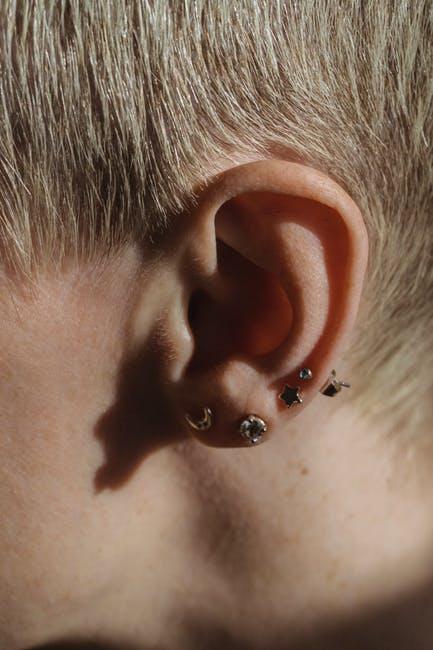Did you know that 33 percent of people that get a piercing in the United States of America end up getting a complication from that piercing? Getting your ears pierced is a great way to change up your style and add a bit of flair to your look. You can pick out earrings that help you express who you are as a person and that reflect things that are important to you.
Learning how to clean ear piercings is critical if you’re trying to avoid getting a painful ear infection down the road. Piercing care isn’t complicated, but you need to remain diligent with it to ensure that your new piercings heal well.
The good news is that you’ve found a great guide for piercing care that will help you avoid any complications with the new piercings that you’re excited about. Keep reading to learn more about how to clean your new earring today!
Clean During Your Hygiene Routine
A great way to get in the habit of cleaning your ear piercings is to incorporate it into your normal hygiene routine. Any time that you go to the bathroom to shower or to brush your teeth you should take the proper steps to provide piercing care. Taking this step will give you the gentle reminder that you need to ensure that your piercing remains healthy.
Always Wash Your Hands
You should also remember the importance of washing your hands before you start cleaning your new piercings. Wash with warm, soapy water to kill any harmful germs and bacteria that might be on your hands. You don’t want to accidentally introduce bacteria to your piercing that might lead to an ear infection.
Clean With a Cotton Swab
The best tool that you can use when you’re learning how to clean ear piercings is a good old-fashioned cotton swab. The piercing parlor where you got your ears pierced at should include a cleaning solution that you should use to care for your piercing over the coming weeks and months.
If you don’t have a cleaning solution or you make your piercing on your own then it’s recommended that you create and use a salt solution. Using this solution two or three times per day on the piercing will kill the bacteria and reduce the risk of infection. It’s especially important to practice this cleaning tip with kids earrings.
Dab the Piercing
Many people that are new to ear piercings make the mistake of thinking that they should wipe the piercing with a cotton swab and cleaning solution. Wiping is a sure way to disturb and aggravate your piercing during the healing period. It’s a much easier and gentler method to dab at the piercing and the hole with the swab to keep it clean and healthy.
Avoid Scented Soaps
Never, under any circumstances, should you use a scented soap as a cleaning solution for your new earring if you care about proper piercing care. If you feel the need to use soap in order to clean your new earring then it’s best to use an antiseptic soap option rather than a scented hand soap.
Clean the Hole
It’s highly recommended that you clean the piercing hole any time you take the old earring out and put a new earring in. Taking the time that you’re swapping earrings is the perfect time to make sure that the hole isn’t infected. You should also use this time to provide an in-depth cleaning session for the piercing.
You should also clean the new earring before placing it in your piercing hole. It could carry harmful bacteria on it despite the fact that it is a new earring. It’s not worth the pain and suffering that comes with an ear infection.
Be careful about where you set your jewelry when you’re not wearing it. Something as simple as setting your earrings on a kitchen counter could result in tons of bacteria getting on them prior to putting them back in your ear piercings. Cleaning the earring before putting it in your ear is a small step that could save you some big trouble.
Don’t Do Piercing Care in the Bathroom
Avoid doing any piercing care in public bathrooms if at all possible. The cleanest bathrooms are still filled with tons of harmful germs and bacteria that you can’t see. Just because a countertop looks spotless doesn’t mean that it is.
It’s common to find much higher concentrations of bacteria in clean home bathrooms than in other parts of the home. A great strategy to try is to find a designated area in your home where you can provide piercing care.
Avoid Sleeping on Your Ear Piercings
It’s a good idea to avoid sleeping on your ear piercings for a bit if at all possible. This might be a tricky task if you’re a side sleeper, but you need to avoid it if you want your piercing care to be a success. Sleeping on your piercings is a sure way to trap bacteria in the piercing hole and get an ear infection.
Keep Shampoo and Body Wash Away
Another thing to look out for if you get a new earring is the avoid getting shampoo and body wash in the piercing hole. The chemicals in these products could irritate the piercing and cause unwanted pain.
Lookout for Discharge
An ear infection will likely cause some oddly colored discharge from the earring hole if you’ve developed an ear infection. If you think that you have an ear infection then it’s a good idea to visit urgent care or the piercing parlor for help and proper piercing care.
Now You’re an Expert on How to Clean Ear Piercings
Learning how to clean ear piercings will save you a lot of time, money, and pain. Practicing extra piercing care like creating a designated part of the home for cleaning your ear and new earring will prevent ear infections and keep you safe. Avoid using scented soaps when cleaning your ear piercings, and always clean the piercing hole when you’re putting in new earrings.
Check out the rest of our blog for more entertaining and engaging content today!





